Silver Power Blue Lightning 600W
by Christoph Katzer on August 27, 2007 6:00 AM EST- Posted in
- Cases/Cooling/PSUs
Test Setup
As usual we are testing with our Chroma programmable loads to fully load each rail to a specific amount. This is important to get truly accurate results and not merely approximate values. The tests are conducted in two different temperature environments. One is normal room temperature of 25-26°C, while the second environment goes from room temperature and increases steadily up to 50°C. Especially during the higher temperatures we will see how good the power supplies are and what they're really made of. Components inside will perform much worse at higher temperatures, but we expect any good quality PSU to deal with such test conditions without failing.
Note: If you would like to know more about our testing methodology, equipment, and environment, please read our PSU testing overview.
3.3V DC Output
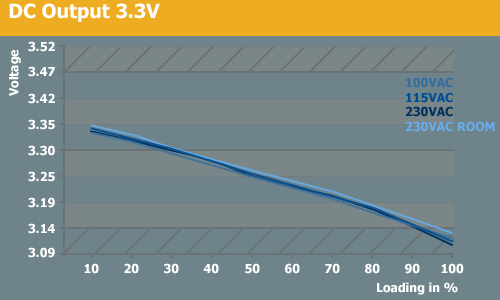
The 3.3V rails were stable during testing, as usual showing a constant drop under increasing load. At maximum loads, the 3.3V rail does go out of spec, regardless of temperature. However, the consistency of the rail outputs regardless of temperature and input voltage is surprising, with all four test results paralleling each other.
5.0V DC Output
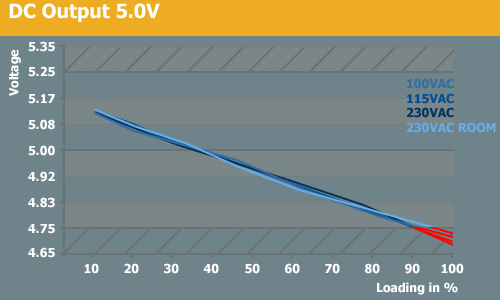
Results with the 5V rail are similar to the 3.3V rail. All four test cases parallel each other, dropping steadily under increasing load. At about 90% load, the 5V rail falls out of spec. It is unlikely that most users will put anywhere near a 90% load on a 600W power supply, and provided you stay below 80% load on the 3.3V and 5V rails there shouldn't be any problems.
5Vsb Output
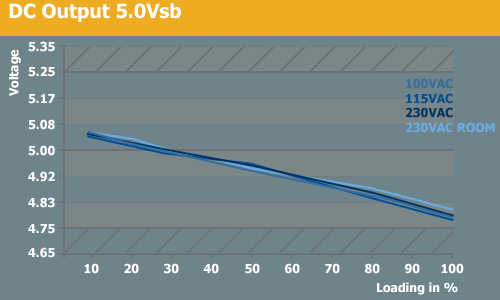
12V DC Output
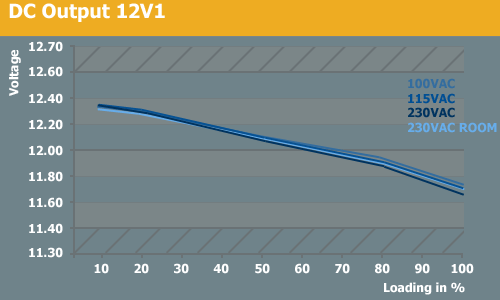
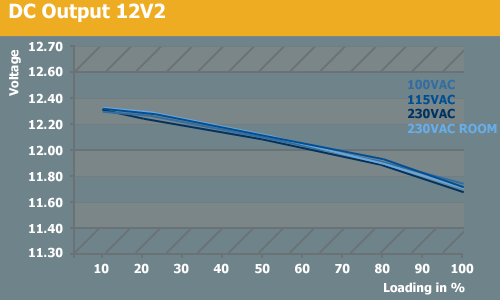
By far the most important rails on any power supply are the 12V rails. Unlike the 3.3 and 5V rails, the Silver Power Blue Lightning delivers a good, stable output on the 12V rails regardless of load. Again, the 12V outputs are very similar regardless of input voltage or temperature, and both rails are also nearly identical.
As usual we are testing with our Chroma programmable loads to fully load each rail to a specific amount. This is important to get truly accurate results and not merely approximate values. The tests are conducted in two different temperature environments. One is normal room temperature of 25-26°C, while the second environment goes from room temperature and increases steadily up to 50°C. Especially during the higher temperatures we will see how good the power supplies are and what they're really made of. Components inside will perform much worse at higher temperatures, but we expect any good quality PSU to deal with such test conditions without failing.
Note: If you would like to know more about our testing methodology, equipment, and environment, please read our PSU testing overview.
| DC Outputs | |||||
| PSU Load | 3.3V | 5V | 12V1 | 12V2 | Wattage (All Rails) |
| 10% | 1.42A | 1.78A | 1.89A | 1.89A | 61.5W |
| 20% | 2.85A | 3.56A | 3.78A | 3.78A | 122.5W |
| 50% | 7.12A | 8.90A | 9.44A | 9.44A | 301.0W |
| 80% | 11.39A | 14.24A | 15.11A | 15.11A | 472.5W |
| 100% | 14.24A | 17.79A | 18.88A | 18.88A | 578.0W |
3.3V DC Output

The 3.3V rails were stable during testing, as usual showing a constant drop under increasing load. At maximum loads, the 3.3V rail does go out of spec, regardless of temperature. However, the consistency of the rail outputs regardless of temperature and input voltage is surprising, with all four test results paralleling each other.
5.0V DC Output

Results with the 5V rail are similar to the 3.3V rail. All four test cases parallel each other, dropping steadily under increasing load. At about 90% load, the 5V rail falls out of spec. It is unlikely that most users will put anywhere near a 90% load on a 600W power supply, and provided you stay below 80% load on the 3.3V and 5V rails there shouldn't be any problems.
5Vsb Output

12V DC Output


By far the most important rails on any power supply are the 12V rails. Unlike the 3.3 and 5V rails, the Silver Power Blue Lightning delivers a good, stable output on the 12V rails regardless of load. Again, the 12V outputs are very similar regardless of input voltage or temperature, and both rails are also nearly identical.










33 Comments
View All Comments
Samus - Monday, August 27, 2007 - link
It appears that a log of people on newegg have this PSU fail after a few months. Now before we get into newegg consumer feedback 'reliability' :) there are a few people who've had these fail, not just one or two.I'm ganna give it a shot anyway. Should work well with my DFI Infinity 975 board, being EPS12v and all.
Slaimus - Wednesday, August 29, 2007 - link
Knowing it is an Apex-built power supply took most of the wind out of its sails. Apex, also known as L&C and Deer, has made some of the most unreliable power supplies ever.This seems to be one of their better efforts, but reliability will always be a concern with this company.
mindless1 - Thursday, August 30, 2007 - link
SMPS tech is reasonably mature beyond present tweaking a bit for higher efficiency, more 12V current, and these without cost rising out of control.Point being, Apex (actually better known as Foxconn or Hon Hai) can easily build quality PSU, it is not inability it is the choice of product placement and construction cost that results in some of the junk we've all seen.
As for reliability, there is a problem as always that you hear of someone with a failed PSU but no autopsy most of the time. No disrespect meant to reviewers, but over the years I can't could how many times a product seemed good at first glance, and second glance (a review period), but later a fault compromised the lifespan. A review of one unit can't take forever, it is going to be inherantly limited in scope, but still must be seen as a way to disqualify products more than qualify them for long term use.